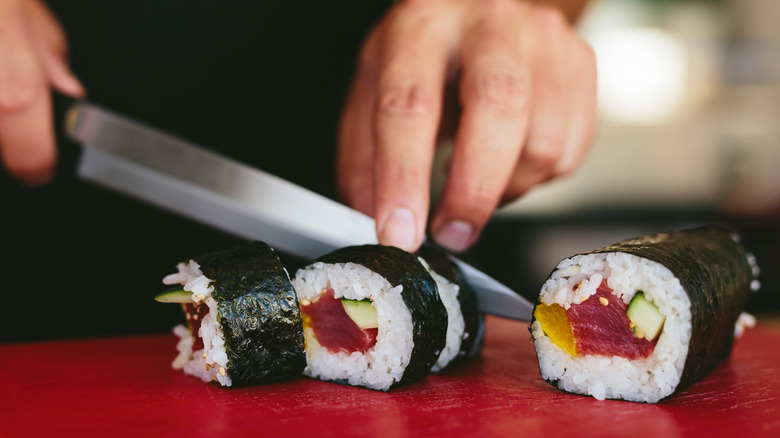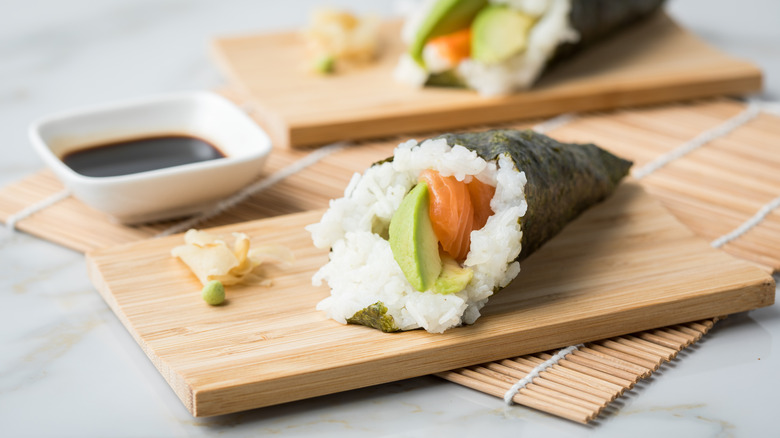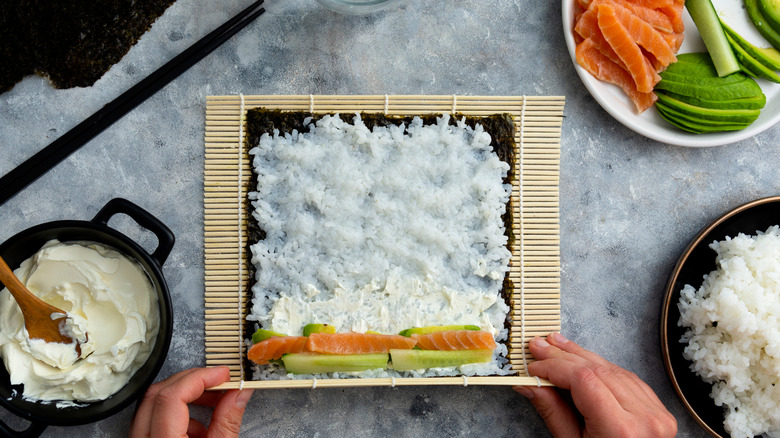The Easy Way To Make Sushi Without A Bamboo Mat
Although some fun sushi accessories might help you in your homemade sushi endeavors, they're not always necessary to make simple and delicious rolls at home. In fact, you can roll sushi even without a traditional bamboo mat, so long as you have a dish towel and plastic wrap. TikTok creator @cupoftj demonstrates how to use this method to make homemade California rolls.
@cupoftj Easy California rolls without a bamboo rolling mat 🍙! #japanesefood #sushi #easyrecipe #learnontiktok #tiktokpartner
The towel offers the stability and flexibility of a bamboo mat, while the plastic wrap keeps your ingredients from sticking to the towel. If you don't have plastic wrap, you can also substitute parchment paper. Just lay the nori in the center of your makeshift mat, add your fillings along the bottom third, and roll. Using fresh rice (preferably short-grain sushi rice) is important because it sticks together far better than dry, old rice.
Be sure to give the length of the sushi roll a gentle squeeze to ensure it stays together once unwrapped, and seal the edges with a dab of water. As seen in the video, you can also press down a layer of rice and then lay nori on top for rolls that feature rice on the outside. This style of sushi is called uramaki, and is far more popular in the United States than in Japan, where traditional makizushi rolls with nori on the outside are preferred.
Other ways to make sushi without using a mat
Afraid you'll mess up when rolling sushi? Some types of sushi are simple enough to make with your own hands and little else. One style is temaki sushi, which translates to "hand roll." These rolls look more like sushi-style ice cream cones than the classic slender makizushi rolls. Just lay out a rectangular piece of nori and pile on your rice and fillings at one end, roughly in the shape of a triangle. Starting with the lower corner closest to your ingredients, roll the nori into a cone shape. Seal the end of the nori wrap with a dab of water, and you're good to go.
Another easy method is making bite-sized sushi balls. Mix together your rice and any other ingredients, diced or sliced finely so they integrate properly. Next, dampen your hands to limit sticking, and form your rice-and-filling mixture into balls. Alternatively, use plastic wrap to shape the rice by dumping a portion onto a piece of wrap, then tying it up to form spheres. Either way, this particular sushi technique is so simple that even kids can help out in the kitchen, and it still tastes just as good. You can even wet one side of a nori sheet to make it sticky, then wrap it around the morsels.
The benefits of investing in a sushi mat
To be clear, we're not saying that a bamboo mat isn't a useful tool to own. It can can certainly come in handy if you make a lot of homemade sushi, and it's sturdier than a dish towel and plastic wrap, making it easier to work with. It also doesn't take up much space in the kitchen, which is a concern with most "unitasking" tools. You can even choose between products than range from simple and cheap to premium versions that will last you a while.
Bamboo mats are made in a couple of different ways, and each mat creates different shapes and textures in your sushi rolls. For instance, cheaper mats are generally made with narrower, more rounded bamboo sticks that result in thinner rolls of sushi. Other mats are made with flat slats of bamboo, allowing you to create thicker rolls. Though a tad more expensive, flatter mats are easier to use, thanks to their easy-to-roll bottom. You can also buy a bamboo mat as part of a sushi-making set, meaning you get other helpful tools.
Of course, these mats aren't for everyone, as they can be difficult to clean and require air-drying. Instead, you can opt for sushi mats made of silicone or plastic, simply tossing them into the dishwasher after each use. No longer does sushi have to be a complicated dish not worth making at home.



